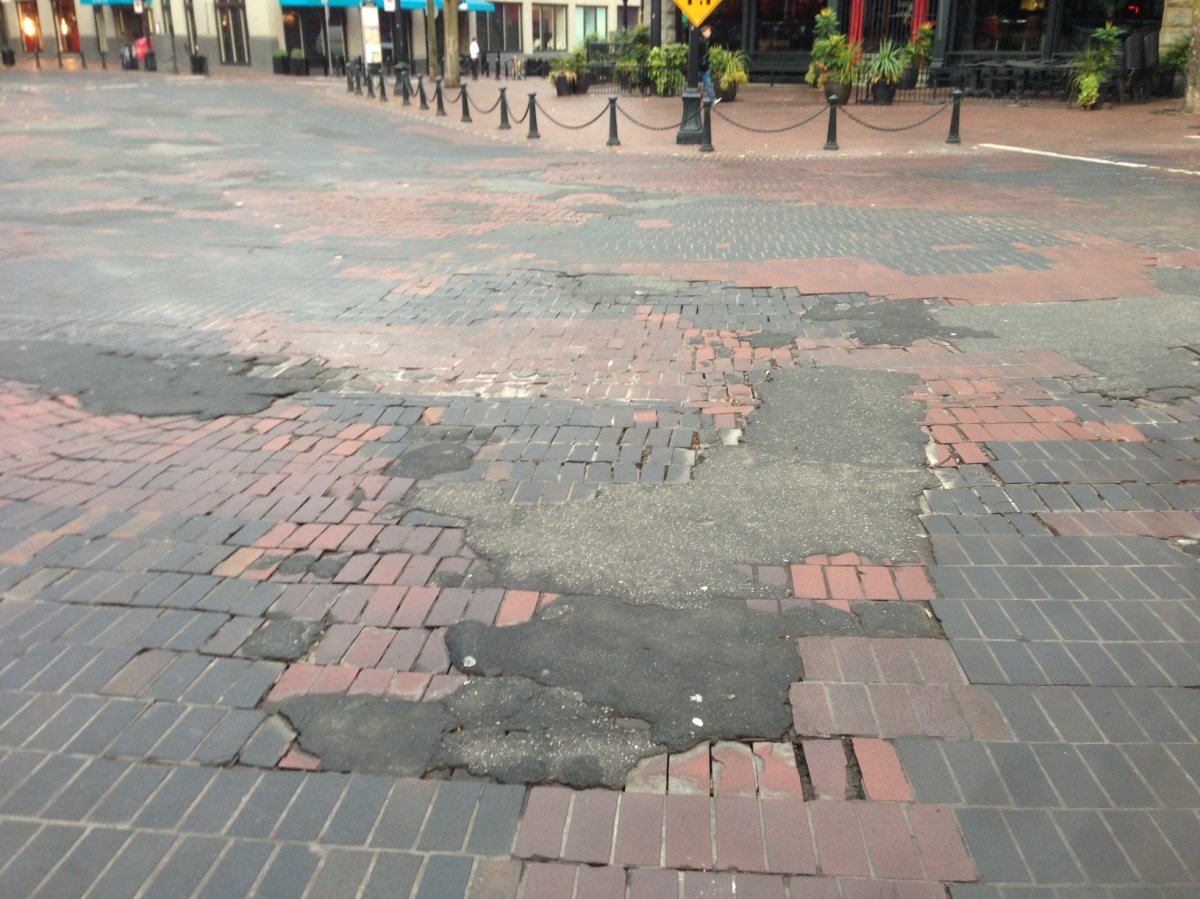The streets of Vancouver’s most famous historic district look more like the streets of Detroit these days, according to an urban planner and developer.

Gastown’s historic Water Street has been undergoing a transformation in recent years, with hundreds of new residents moving in and hip boutiques and restaurants setting up shop.
At the same time, Water Street has also been undergoing another kind of transformation — every time a tile or cobblestone breaks, the city has been patching up the street with a mosaic of messy asphalt.
The area’s current historic cobblestone look was actually created in the mid-1970s as part of a neighbourhood beautification program. The road is actually not cobblestone as many believe, but is lined with faux tiles. There are some cobblestone curbs, however.
Urban planner and developer Michael Geller says the city’s current practice of filling-in missing pavers with asphalt is completely out of step with what’s happening in other cities.
“It’s completely wrong to try and replace the missing pavers and cobblestones with asphalt. This is an important heritage area of the city. I travel a lot, and you go to most cities in Europe, and even many American cities, and they are replacing asphalt with pavers to enhance the pedestrian experience and to improve the appearance of the street.”
“This is the sort of thing you would expect in Detroit — not in Vancouver,” he says.
- Three B.C. men fined, banned from hunting after killing pregnant deer
- B.C. child-killer’s attempt to keep new identity secret draws widespread outrage
- Inquest hears B.C. hostage was lying on her captor before fatal shooting
- ‘We’ve had to make a 180’: What Oregonians say they got wrong with decriminalization
The neighbourhood is often the first area tourists see after they arrive at the nearby cruise ship terminal. The steam clock continues to attract tens of thousands of tourists every year, waiting for the all-important hourly whistle.
Leanore Sali, Executive Director of the Gastown Business Improvement Association, says the condition of the street is a concern, and they are working with the City of Vancouver to come up with a solution.
“We’re obviously really concerned about it, and it’s seriously important to us. We don’t like the aesthetics, but it hasn’t had a huge impact on our businesses. We are just really aware of it, and we know it needs to be dealt with, and it’s on our radar and the city’s radar.”
Sali says the city has hired a consultant to study the underlying conditions of the roadway and the BIA is expecting to be presented with a series of possible solutions by the end of the year.
City Engineer Peter Judd says the consultant hasn’t been working as quickly as they would have liked.
“We’ve hired a consultant, they’re not as far as I would like them to be, and I haven’t seen any options from them so far, but what I am aiming for is to have some proposals that we can consider in the next capital plan, that will go to plebiscite as part of the November 2014 municipal election.”
Judd says they need to make the roadway safe when a tile or brick falls apart.
“When you get a hole, you have to make it safe, and it takes time to do brickwork properly, but there’s no intention to leave a patchwork of asphalt like that, but I also don’t want to spend a lot of money fixing up something that may change.”
Geller says the current condition of Water Street is even more perplexing considering the city’s recent push for more bike lanes.
“It’s completely backwards to my mind to be using asphalt at the same time as the city is spending significant amounts of money on the new bike lane infrastructure, much more than really needs to be spent, at the same time, the city is encouraging private developers to use pavers, other than asphalt or concrete.”
The city says they can’t source the tiles anymore and they are left with no other choice than asphalt to patch up areas that are missing tiles.
“Gastown is a priority, and that’s why we have hired a consultant,” says Judd.
Geller says the city could be trying harder to find a similar tile that would fit.
“Eventually you find a tile that is somewhat similar, if you can’t find the identical one, but just through the installation and design, you can make it look like something other than simple patchwork. It doesn’t make sense. Sometimes we start taking these things for granted, and you have to think about not just what it looks like tomorrow, but what it will look like 15 or 30 years from now.”
Judd says the major issue right now is that what is currently installed is not maintainable.
“Between now and then, we need to work out some options, and come up with something that has a longer life and has the same historic feel to it, and get something down there that is maintainable because what is down there now is sort of falling apart, and just isn’t maintainable.”
Judd estimates any reconstruction project would cost between $10 to $20 million dollars with money coming from the street reconstruction portion of the capital budget.
An estimated 11,000 to 13,000 vehicles use Water Street daily, including many large tour and transit buses.
















Comments